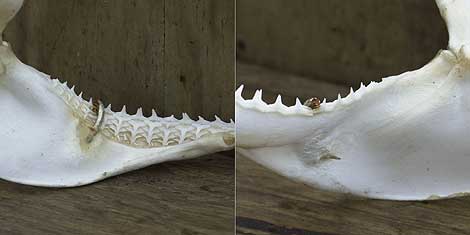
|
|
|
|
|
|
Shark Info (11-04-2002) |
Author |
|
Intro: |
Shark Info |
|
Main article: |
Dr. A. J. Godknecht, Dr. G. D. Guex |
|
Article 1: |
Shark Info |
|
Article 2: |
Pathological changes caused by fish hooks on the blue shark (Prionace glauca) |
Shark Info |
Article 3: |
Shark Info |
|
Fact Sheet: |
Shark Info |
|
Sharks in Research and IndustryReport by Shark Info Pathological changes caused by fish hooks on the blue shark Prionace glauca.
Blue sharks are often caught as bycatch by longline fisheries.
During the catch period between 1993 and 1995 it is estimated that
between 50 and 120,000 individuals were caught annually alone in the
North Atlantic catch area. Blue shark meat is not deemed
commercially interesting, especially since legal catch regulations
limit the quotas in the U.S. According to the authors, about 81% of
the animals caught on hooks are released alive.
For
example, during a two-day competitive fishing event in Massachusetts
over 2,000 blue sharks were caught, 99% of which were apparently
released alive. Unknown is how many of these animals die later on as
a consequence of the traumatic catch. In any case many of these
sharks have problems with fishing hooks stuck in their jaw, their
gullet or intestinal tract. The hooks begin to rust and trigger
antibody reactions in their bodies. Source: Journal of Fish Diseases 25 (9), pp 515-521. Borucinska J., Kohler N., Natanson Skomal, G. (2002). Pathology associated with retained fishing hooks in blue sharks, Prionace glauca (L.), with implications for their conservation.
|
||||||||||||
